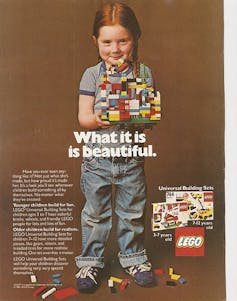
Source: Unsplash/Ravi Palwe.
Lego announced this week it would work to remove gender stereotypes from its brand, including no longer marketing toys distinctly to boys or girls and ensuring products are gender-neutral.
This move by one of the world’s most powerful brands comes in response to research the Danish toy manufacturer commissioned to understand how parents and children think about creativity.
The survey of nearly 7000 parents and children across seven countries found strong endorsement of traditional gender roles among both boys and girls, with 78% of boys and 73% of girls agreeing “it’s okay to teach boys to be boys and girls to be girls”.
71% of boys were worried about being judged or made fun of for playing with toys gendered for girls and 54% of parents worry their sons will be made fun of if they play with toys associated with girls, compared to only 26% of parents worrying about the reverse.
Overall, the results suggest boys feel more pressure to conform to gender roles and norms for creative activities than girls. But the perceptions and beliefs of others may also be holding girls back. When toys are gendered, all children pay the price.
We recently conducted a systematic review of gender stereotypes and biases in early childhood.
Awareness of gender as a social category develops early in life, and insight into some gender stereotypes begins early. For example, preschool aged children can hold beliefs such as only boys can be policemen and only girls can be teachers or nurses.
Gender and racial stereotyping and prejudice can be observed in children as young as three to four years of age, as children take on cues from around them to decode and understand the world.
Shopping and ‘fixing things’
When children observe different toys and tasks for different groups, they can learn stereotypes and prejudices, such as viewing shopping as an activity for girls and “fixing things” and using tools as activities for boys. This can reinforce rigid binary views of gender.
Such stereotypes and prejudices can be carried throughout life, making early childhood critical for setting the foundations for lifelong attitudes.
The Lego research found parents were more likely to encourage their daughters to engage in activities that are more cognitive, artistic and performative (dressing up, dancing, colouring, singing and arts and crafts), and more likely to encourage their sons to engage more in digital activities, science and building.
Beliefs and expectations about what types of toys and play are appropriate for girls and boys can compound over time.
Some studies show that play with some stereotypical girls’ toys, such as princess toys, is associated with more female gender-stereotypical behaviour among children.
Not engaging in play with construction toys may mean girls miss opportunities to develop spatial skills and mechanical reasoning skills necessary for careers in science, technology, engineering and mathematics: fields in which women continue to be under-represented.
Rigid gender lines
Toys are only one way in which children learn gender roles and stereotypes: they also learn from who they see around them in their daily lives, from the books they read and the TV shows they watch.

Lego’s advertising, like this one from 1981, shows the company used to be a lot less rigid around gender. Source: Lego.
Parents and caregivers have a key role in encouraging children of all genders to engage with a wide range of activities and toys.
But since the 1970s, toys have become increasingly and rigidly demarcated along binary gender lines.
Even Lego’s own marketing history demonstrates this: compare the gender neutral advertisements from the early 1980s to more recent gender specific marketing with pink bricks and heart shapes.
The prevention of potentially harmful gender attitudes and stereotypes in childhood — before they become entrenched — is a key element in moves to achieve gender equity and to support health and wellbeing throughout life.
Efforts to reduce the gendered nature of toys and their marketing is one step we can take to give all children more equitable options for how they see themselves, the world, and their future.
This article is republished from The Conversation under a Creative Commons license. Read the original article.
Handpicked for you

How LEGO is reducing plastic without compromising its product

COMMENTS
SmartCompany is committed to hosting lively discussions. Help us keep the conversation useful, interesting and welcoming. We aim to publish comments quickly in the interest of promoting robust conversation, but we’re a small team and we deploy filters to protect against legal risk. Occasionally your comment may be held up while it is being reviewed, but we’re working as fast as we can to keep the conversation rolling.
The SmartCompany comment section is members-only content. Please subscribe to leave a comment.
The SmartCompany comment section is members-only content. Please login to leave a comment.